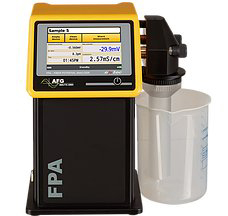Paper fiber potential analyzer

Paper fiber potential analyzer
Surface charges of fibers, fillers, particles or colloidal dissolved matters in stock suspension are defined by the Zeta Potential on their surfaces. The charge of the stock suspension can be split into the colloidal and particle charge, measured with the CAS Charge Analyzing System, while the fiber and filler charge is measured with the FPA Fiber Potential Analyzer. All both charge levels together defining the overall Zeta Potential of fiber suspensions.
The knowledge of the fiber charges in the pulp is the key for optimized dosage of chemical aids which should adsorb on the fiber. The mostly negative (anionic) charged fiber is adsorbing the positive (cationic) charged additives in the paper-making process. The optimized dosage of such aids always depends on the Zeta Potential within the pulp.
The FPA is designed to determine the Zeta Potential of fibers according to the Helmholtz-Smoluchowski equation by simultaneously measuring conductivity, pressure and the streaming current potential. The measuring principle is based on the streaming current potential measuring method in a fiber plug. That fiber plug is automatically build up on a screen electrode in the measuring cell of the FPA with the help of a vacuum. By periodically changing the vacuum during the measurement the charge clouds absorbed on the fibers are moving with the liquid stream and generating the streaming current potential measured by the screen and ring electrode.
The knowledge of the fiber charge enables a correct and effective dosage of the charged chemical additives. The fiber adsorption of cationic starch, wet strength resin, and many other chemical aids can be easily measured with original samples on-site to optimize the dosage of chemicals in the wet end of the paper manufacturing process.
The example below explains the dosage of cationic starch in pulp containing some anionic trash. With begin of the dosage the cationic starch is caught by the anionic trash and is not adsorbed on the fibers. The Zeta Potential of the fiber is not changing. After increased dosing the fiber will adsorb the cationic starch.
Features
- Menu controlled fully automatic measuring procedure
- Simple handling, robust design, high accuracy and reproducibility
- No big and noisy external vacuum pump
- No manual adjustment of pressure control: pressure is controlled automatically by computer
- Integrated pH measurement
- Portable: Only one device, low weight, transportation case with rolls
- Automatic, menu controlled cleaning of the system
- Automatic removal of the fiber plug after the measurement
- Simple removal of filtrate
- Measuring results compatible to comparable devices
- All components (measuring electronics, micro controller, control systems) are at the latest technological standard
- Controlling and processing of data by most modern micro controller
- No external connection cable for electrodes - thereby prevention of handling errors
- Storage of data on an internal CF Memory Card for data to export and evaluation by PC
- High performance PC software for data logging, display, evaluation and storage
- Data readout via display and integrated printer
- Display of trends are possible
- Integrated vacuum pump water protected: pump cannot be destroyed by filtrate overflow